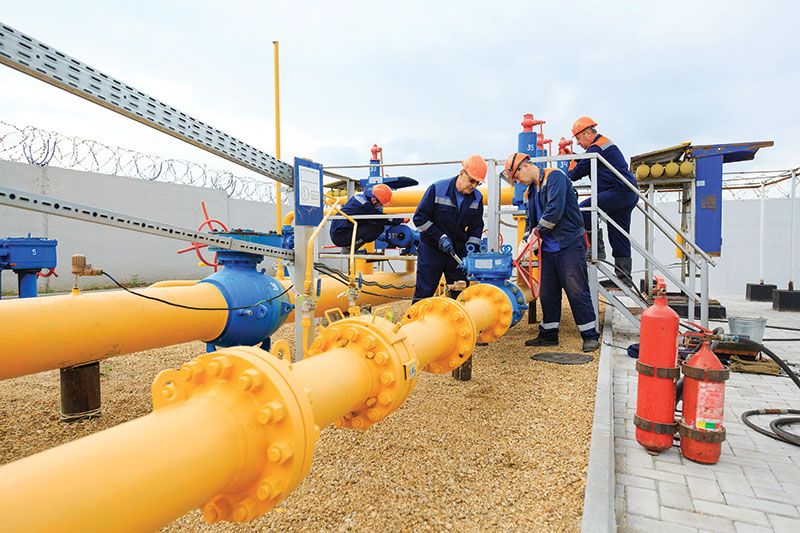January 2023, Vol. 250, No. 1
Government
EPA Ups Ante on Pipeline Methane Emissions

By Stephen Barlas, Contributing Editor, Washington, D.C.
(P&GJ) — The U.S. Environmental Protection Agency (EPA) has once again proposed to tighten the vise on interstate pipeline methane emissions. EPA’s supplemental Clean Air regulatory proposal in November 2022 doubles down on a never-finalized proposed rule issued in November 2021, which the transmission industry slammed for unrealistic emission controls on wet seal compressors, pneumatic controllers and rod packing and other equipment.
With the new proposal, announced while President Biden was at the COP27 (27th Conference of the Parties to the United Nations Framework Convention on Climate Change) in Egypt in November, EPA goes from bad to worse.
In the supplemental proposed rule, the agency wants to tighten standards on wet seal compressors even more. To agitate the pipeline industry further, EPA wants to regulate centrifugal compressors with dry seals for the first time. Other new control mandates, some of which have been upgraded since the 2021 proposal, include increasing the kinds of controllers to which emission limits apply and eliminating an industry standard for annual maintenance of rod packing in compressors.
EPA presents no estimates of the cost to the interstate pipeline industry of these control requirements nor the extent to which they allow for methane emissions reductions compared to current emission levels.
This new proposal contains stricter methane and volatile organic chemical (VOC) emissions for the entire oil and gas industry and across various production, transmission and equipment segments. It is complicated because there are three separate sections of the Clean Air Act that impact facilities based on when they were put into operation: before 2011, before 2015 and those in the future that are new or modified.
This “supplemental” proposed rule (meaning an upgrading of the November 2021 proposal) covers 500 pages and touches on provisions dealing with advanced methane detection technologies, a new super-emitter response program, pneumatic controllers, pneumatic pumps, centrifugal compressors, combustion control devices and reciprocating compressors.
In establishing standards, EPA, for most part, applies a methodology called the best system of emission reduction (BSER), which takes into account the cost of achieving the specified emissions reduction and any non-air quality health and environmental impact and energy requirement the Administrator determines have been adequately demonstrated.
One bit of welcome news for the industry is that the EPA will not establish emissions standards for pipeline pigging; although, some states do have such standards.
This new mega-proposal keeps as an alternative the November 2021 proposal to reduce methane emissions from each centrifugal compressor wet seal fluid degassing system by 95%. Kinder Morgan called the 95% reduction standard “unworkable and untethered from real-world application of such controls, which have not been demonstrated.” EPA believed that to comply with that standard, pipelines would route the methane or VOC emissions to either a control device or a process.
The new November 2022 supplemental proposal keeps that 95% requirement as a potential alternative to its new “presumptive” (meaning likely choice) proposed standard of keeping methane and VOC emissions from self-contained wet seal centrifugal compressors to less than 3 standard cubic feet per minute (scfm).
EPA admitted that when self-contained wet seal compressors are operating properly, they emit trivial amounts (i.e., achieve greater than 99% control) of methane.
EPA recognizes that where there is venting of any emissions from these compressors, emissions would more than likely be nondetectable for leaks, or would be at a rate lower than 3 scfm. With that in mind, the EPA says it is open to a lower numerical limit.
In its comments on the 2021 proposal, the Interstate Natural Gas Association of America (INGAA) argued, “EPA’s perception and estimates of wet seal emissions, however, are based on compressors of a certain type and vintage that are not representative of most wet seal compressors in the transmission and storage sector.”
In addition, dry seals would be regulated for the first time and subject to the same 3 scfm volumetric flow rate emissions limit that the EPA copies from California’s Regulation for Greenhouse Gas Emission Standards for Crude Oil and Natural Gas Facilities.
“In the 2021 notice, the EPA noted that emissions from dry seals are a relatively small contributor, so the related support documentation for adding this control requirement will be closely reviewed,” states Scott Yager, vice president of Environment at the INGAA. “Especially since past EPA actions in and voluntary programs promoted dry seal technology over wet seals.”
Katherine Hill, spokesperson for Kinder Morgan, said the company has no comment on the new supplemental proposal beyond the concerns it voiced about the November 2021 proposed rule.
The new requirement to control dry seal emissions will undoubtedly be controversial as will many other aspects of the supplemental, such as the “Super-Emitter” program. There, not only governmental bodies but “third parties” will be able to finger a company in cases where methane emissions are beyond 100 kilograms per hour, which EPA says would be an unusual event, and therefore a target for immediate redress.
To detect such super emissions, EPA would allow surveillance of oil and gas operations by third parties using remote-sensing aircraft, mobile monitoring platforms or satellites. EPA will have to approve the third parties. These approved notifiers could be any third party, including but not limited to, technology vendors, industry, researchers, nonprofit organizations or other parties demonstrating technical expertise as described.
Matthew Hite, vice president of Government Affairs, GPA Midstream Association, and his group are still combing through the 500-page Federal Register notice. “Off the top of my head, we weren’t thrilled with the third-party enforcement portion of it,” he said.
EPA is considering a process of disqualifying any third party that a pipeline can prove made “meaningful, demonstrable errors” in three notices at the same site. The EPA does not plan to review the notifications to energy companies from third parties. It says it has done its due diligence in certifying those parties, so presumably the Super-Emitter “finder” squad will make legitimate notifications.
When a third party notifies an energy company of a super-emission, EPA is proposing to require initiation of the root cause analysis and corrective actions within five calendar days of an owner or operator receiving the notification of the super-emitter emissions event, and completion of corrective actions within 10 days of the notification.
EPA does not alter its 2021 proposal of a VOC and methane emissions rate of zero for pneumatic controllers (continuous bleed and intermittent vent). Leaking controllers would have to be replaced over a two-year period.
The agency does make two changes, however, by including two specific types of natural-gas-driven controllers that were proposed to be excluded from the affected facility definition. These are (1) controllers where the emissions are collected and routed to a gas-gathering flow line or collection system to a sales line (used as an on-site fuel source or another useful purpose that a purchased fuel or raw material would) and (2) self-contained natural gas pneumatic controllers.
Another change is that in 2021 EPA said it wanted to regulate controllers individually. Now the agency has changed its mind and says a “facility” is the collection of all the natural gas-driven pneumatic controllers at a site because most of the zero-emissions measures for pneumatic controllers are site-wide solutions.
INGAA argued that pneumatic controllers used in natural gas transmission and storage should be exempt from regulation, because they are not a significant contributor of methane from the transmission and storage segment. EPA turned a deaf ear and keeps the zero-emission standard for the transmission sector in the 2022 supplemental proposal.
The new standard for rod-packing maintenance on reciprocating compressors contained in the 2022 supplemental proposal is also getting INGAA’s attention. EPA appears to ditch the current annual monitoring schedule requirement (by flow rate measurements) and replace it with a standard of performance of 2 scfm, based on 8,760 hours of operation. That was part of the 2021 proposal.
But in the 2022 proposal, EPA, in an apparent gesture of flexibility, allows pipelines to repair the rod packing to keep emissions below 2 scfm, as opposed to requiring complete replacement of the rod packing.
EPA in 2021 also offered an option of routing rod packing emissions to a process via a closed vent system. It would have to be done “under negative pressure.” The 2022 supplemental eliminates the negative pressure requirement.
INGAA’s Yager wants the EPA to retain the annual monitoring requirement as an alternative instead of imposing the 2 scfm emissions limit as the sole means of control.
“INGAA strongly recommends that EPA retain both options for added flexibility, with the operator selecting their preferred approach,” he explained.






Comments